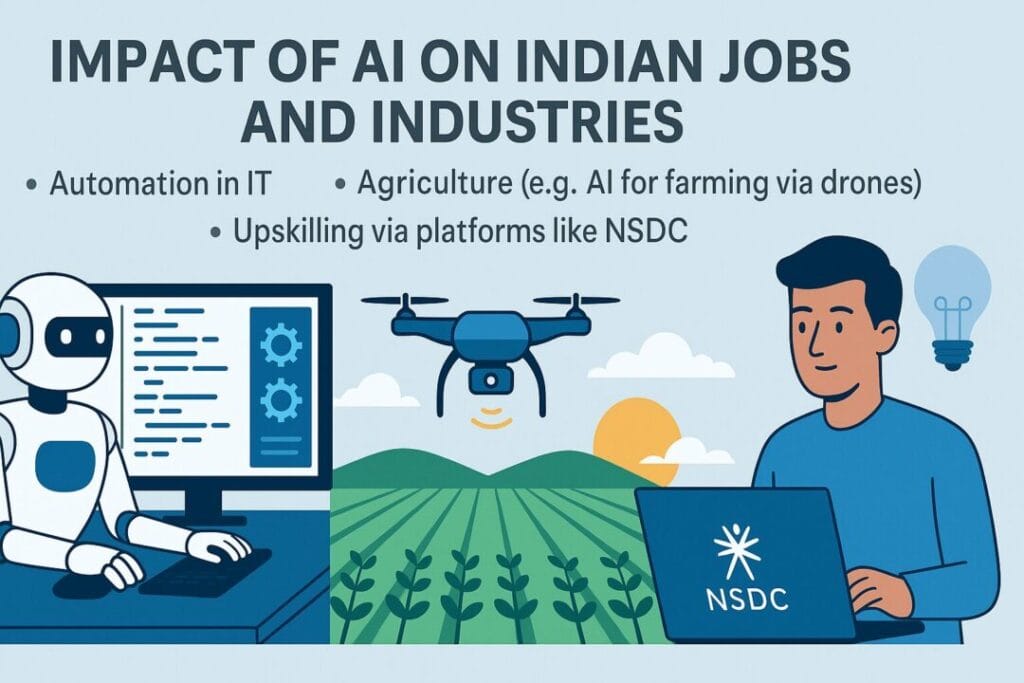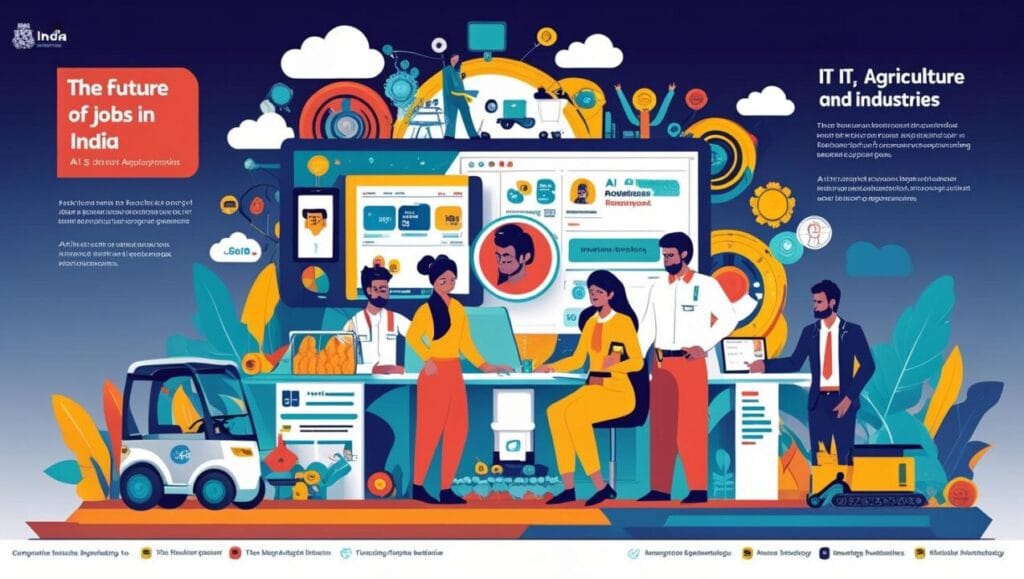
Table of Contents
Impact of AI on Indian Economy, Jobs and Industries
Artificial Intelligence (AI) is no longer a futuristic buzzword; it is a present-day reality shaping the core of India’s workforce and industries. From the buzzing tech hubs of Bengaluru to the vast farmlands in Punjab, AI is making its mark in ways both disruptive and transformative. For India—a country with a workforce of over 500 million—understanding how AI impacts jobs and industries is not just important, it’s critical for economic survival and growth. In this article, we will explore how AI is revolutionizing sectors such as IT, agriculture, healthcare, and manufacturing, while also addressing the big question: will AI create more jobs than it replaces?
Introduction to AI and Its Growing Influence in India
Artificial Intelligence refers to the simulation of human intelligence in machines that can learn, reason, and make decisions. Globally, AI is at the forefront of innovation, and India is no exception. With one of the youngest workforces in the world and a booming digital economy, AI adoption in India is accelerating faster than ever.
What is Artificial Intelligence?
In simple terms, AI is the ability of a computer system to mimic tasks usually requiring human intelligence, such as problem-solving, decision-making, language understanding, and image recognition. Unlike traditional software that follows predefined instructions, AI learns and improves with experience through machine learning and deep learning.
For example, the voice assistant on your phone, the product recommendations you get on Flipkart, or even fraud detection in digital banking—all of these are everyday AI applications that Indians are already using without realizing it.
Why AI Matters for India’s Economic Future
India’s economy is heavily reliant on both its IT sector and agriculture, which collectively employ hundreds of millions of workers. AI has the power to boost productivity, improve decision-making, and cut costs, but it also has the potential to displace jobs if the workforce is not prepared.
According to NASSCOM, AI could add $450–500 billion to India’s GDP by 2025, but only if industries and workers embrace the transition. The growing AI influence means that every Indian worker—from a software engineer to a farmer—must learn how to work alongside AI rather than against it.
Transformation of the Indian IT Industry through AI
The Indian IT industry has always been the backbone of the economy, contributing significantly to exports and global outsourcing. With AI entering the scene, the IT sector is going through its biggest evolution since the rise of the internet.
Automation of Repetitive IT Tasks
One of the most immediate impacts of AI in IT is automation. Tasks such as software testing, bug fixing, data entry, and customer support are being handled more efficiently by AI-driven bots. For instance, chatbots powered by natural language processing (NLP) are now capable of resolving customer issues without human intervention.
This automation reduces costs for companies but raises concerns about job losses, especially in entry-level roles. However, automation also frees up human workers to focus on higher-level problem-solving and innovation.
AI in Software Development, Cybersecurity, and Cloud Services
AI is revolutionizing software development with tools that can write and optimize code automatically. Platforms like GitHub Copilot, powered by AI, assist developers in writing cleaner and faster code. Similarly, in cybersecurity, AI-driven systems can detect unusual patterns and prevent cyberattacks faster than human analysts.
In cloud computing, AI plays a major role in resource optimization, helping businesses scale more effectively. This means Indian IT companies offering cloud services are now becoming global leaders in AI-enabled solutions.
Job Shifts: From Coders to AI Specialists
While traditional coding jobs may decline, new roles are emerging in AI research, machine learning engineering, data science, and AI ethics. The IT workforce in India is increasingly expected to transition from routine coding tasks to specialized roles that require creativity, critical thinking, and advanced AI knowledge.
For example, instead of just being “coders,” future IT professionals may need to act as “AI trainers,” teaching machines how to recognize patterns and make decisions. This shift makes upskilling crucial for IT professionals if they want to stay relevant in the AI era.
AI in Agriculture: Revolutionizing Indian Farming
Agriculture remains the backbone of India’s economy, employing nearly 40% of the workforce. However, Indian farming faces challenges like unpredictable weather, water scarcity, low productivity, and supply chain inefficiencies. AI is stepping in as a powerful solution to these long-standing problems.
Smart Farming with Drones and Sensors
Farmers are now using AI-powered drones to monitor crop health, spray fertilizers, and detect pest infestations. These drones provide real-time data, allowing farmers to take immediate action rather than waiting for visible crop damage.
Similarly, AI-enabled sensors in soil can detect moisture levels and recommend precise irrigation schedules. This “smart farming” reduces water wastage and increases crop yield, making agriculture more sustainable.
Predictive Analytics for Crop Yield and Weather Forecasts
AI models can analyze historical data and predict crop yields with impressive accuracy. For example, AI tools can forecast monsoon patterns or alert farmers about upcoming droughts. This predictive power allows farmers to plan better, reduce losses, and maximize profits.
In states like Andhra Pradesh and Karnataka, pilot projects are already running where AI helps farmers decide the best time for sowing and harvesting.
AI Tools for Market Access and Supply Chain Efficiency
Beyond farming itself, AI is helping farmers connect with markets directly. Platforms powered by AI predict market demand and suggest the best prices for crops. This reduces the role of middlemen and ensures farmers get fair value.
Moreover, AI is optimizing supply chains by predicting transportation delays, minimizing food waste, and ensuring fresh produce reaches consumers faster.

Impact of AI on Other Key Industries
While IT and agriculture are leading the way, AI is also making significant inroads into other critical industries across India.
AI in Healthcare: Diagnostics and Telemedicine
India faces a shortage of doctors, especially in rural areas. AI-powered diagnostic tools are bridging this gap by analyzing X-rays, MRIs, and blood reports with high accuracy. Telemedicine platforms use AI to recommend treatments and monitor patients remotely, making healthcare more accessible.
AI in Retail and E-commerce: Personalized Shopping Experience
E-commerce giants like Amazon India and Flipkart use AI for personalized product recommendations, inventory management, and fraud detection. AI-powered chatbots handle customer service, while predictive analytics helps businesses anticipate demand.
AI in Manufacturing: Robotics and Quality Control
In Indian factories, AI-powered robots are handling repetitive assembly line tasks with precision. AI-driven quality control systems identify defects in real time, reducing waste and improving efficiency. This is pushing Indian manufacturing closer to “Industry 4.0,” where smart machines collaborate with human workers.
Job Displacement vs. Job Creation in the AI Era
The big question is: Will AI create more jobs or take them away?
Which Jobs Are at Risk in India?
Jobs that involve repetitive tasks, such as data entry, telemarketing, and basic customer support, are most at risk of automation. Low-skilled IT roles like manual software testing may also decline.
New Job Roles Emerging Due to AI
At the same time, AI is creating new opportunities. Roles such as data scientists, AI engineers, drone operators, and AI ethics specialists are in demand. Even in agriculture, jobs for drone pilots and AI-based farm advisors are emerging.
Human-AI Collaboration: The Middle Ground
Instead of replacing humans, AI often works best when complementing human intelligence. Doctors supported by AI diagnostics, teachers supported by AI learning platforms, and farmers assisted by AI drones—these hybrid roles show how collaboration, not replacement, is the real future of AI in India.
The Role of Upskilling and Reskilling in India
The arrival of Artificial Intelligence is reshaping industries, but the most critical question is—are Indian workers prepared for this change? The answer depends on how effectively the country embraces upskilling and reskilling initiatives. Without these, millions could be left behind as automation advances.
Importance of Upskilling for Future Job Security
Upskilling refers to acquiring new skills relevant to evolving industries, while reskilling involves learning completely new skills to switch careers. In an AI-driven economy, these are no longer optional—they are survival tools.
For example, IT workers skilled only in basic coding may find their roles threatened by automation. However, by learning AI programming, machine learning, or data analytics, they can transition into high-demand roles. Similarly, a farmer learning to operate AI-powered drones can increase productivity and income rather than being displaced by new technologies.
Upskilling also strengthens job security. Workers who invest in continuous learning are less likely to become obsolete. Just as typing and computer literacy were must-have skills 20 years ago, AI literacy is becoming essential today.
Role of NSDC (National Skill Development Corporation) in AI Training
The National Skill Development Corporation (NSDC) has emerged as one of the key players in preparing India’s workforce for the AI era. Established under the Ministry of Skill Development and Entrepreneurship, NSDC has partnered with private companies, universities, and tech platforms to deliver AI and digital skills training.
NSDC initiatives include:
Skill India Mission – Focused on training millions in emerging tech skills.
AI-based training programs – Providing structured courses on AI, machine learning, and data science.
Partnerships with tech giants – Collaborations with Microsoft, Google, and IBM to deliver cutting-edge AI learning modules.
By bringing AI education even to rural areas, NSDC ensures that India’s workforce doesn’t just adopt AI but also leads in its implementation.
Popular AI and Tech Upskilling Platforms in India
Apart from government-led initiatives, private learning platforms are also playing a huge role in reskilling Indians for AI jobs. Platforms like UpGrad, Coursera, Great Learning, NPTEL, and Simplilearn are offering AI and data science courses that are industry-relevant and affordable.
For instance, an IT professional can enroll in a machine learning course on Coursera and transition into a data scientist role, while a farmer can attend an NSDC workshop on using AI-driven soil sensors.
The combination of government, industry, and private edtech platforms is creating an ecosystem where every Indian—whether in cities or villages—has a chance to benefit from AI rather than fear it.
Government Initiatives to Promote AI Adoption and Employment
The Indian government recognizes the potential of AI not just for industrial growth but also for job creation and social development. To ensure AI benefits everyone, several initiatives are underway.
Digital India and AI for All
The Digital India mission has laid the foundation for widespread AI adoption by improving internet penetration, digital literacy, and e-governance. Building on this, the government has launched the AI for All initiative, which aims to introduce AI learning to students, professionals, and even the general public.
This includes:
Free AI learning modules in regional languages.
AI curriculum for schools and colleges.
AI awareness campaigns to help citizens understand its benefits.
India’s National AI Strategy (NITI Aayog)
In 2018, NITI Aayog released a national strategy called “AI for All.” The focus areas include healthcare, agriculture, education, smart cities, and mobility. The government aims to make India a global hub for AI research and innovation by investing in AI startups and building AI research centers.
One highlight is the creation of Centers of Excellence in AI, where academia, industry, and government collaborate on projects ranging from AI-powered farming to smart transportation.
Public-Private Partnerships in AI Training
The government is actively partnering with private companies to bridge the AI skill gap. Examples include:
Microsoft’s AI School of India – Training developers in AI tools.
IBM SkillsBuild Platform – Offering free AI and data science courses to students.
Google’s AI for Social Good Program – Supporting AI solutions for Indian challenges like flood forecasting and agricultural planning.
By working hand-in-hand with the private sector, the government ensures AI adoption doesn’t just serve big corporations but also uplifts small businesses, students, and rural communities.

Challenges of AI Integration in India
While the potential of AI is enormous, India faces several challenges in ensuring smooth integration of AI into jobs and industries.
Skill Gaps in Rural vs. Urban Workforce
India’s workforce is split between urban professionals working in IT and rural workers dependent on agriculture. While urban workers may have access to online AI learning platforms, rural workers often lack digital infrastructure and awareness. Bridging this digital divide is one of the biggest challenges in ensuring equitable AI adoption.
Data Privacy and Security Concerns
AI systems thrive on data, but with increasing data collection comes the risk of misuse. Concerns about privacy, cybersecurity, and ethical AI use are growing. For example, while AI can track consumer behavior for personalized marketing, misuse of such data can lead to exploitation and fraud. India needs stronger regulations to balance AI innovation with ethical concerns.
Economic Inequality and AI Access
There’s a fear that AI may deepen economic inequality. Large corporations with AI infrastructure may thrive, while small businesses and workers without access may fall behind. Unless AI is made affordable and accessible, its benefits may remain limited to a privileged few.
Future Outlook: AI-Driven India
Looking ahead, AI is set to become one of the biggest economic drivers for India. But will it truly transform India into a global AI powerhouse?
Potential Economic Impact of AI by 2030
According to PwC, AI could add nearly $1 trillion to India’s economy by 2030. This impact will come from higher productivity, smarter supply chains, and more efficient industries. If India plays its cards right, AI can turn challenges like unemployment and low agricultural productivity into opportunities for growth.
AI as a Driver for Inclusive Growth
AI isn’t just about big industries. From rural farmers using AI for better crops to students in small towns learning AI coding online, this technology has the power to create inclusive growth. By democratizing AI access, India can ensure both urban and rural communities benefit equally.
How India Can Lead in Global AI Innovation
India has the talent pool, the IT backbone, and a large consumer base to become a leader in AI. By focusing on AI education, affordable AI solutions, and ethical AI governance, India can not only adopt AI but also export AI solutions to the world.
If nurtured correctly, India’s AI journey won’t just be about catching up with global leaders like the US and China—it could be about setting the standards for responsible and inclusive AI development.
Conclusion
Artificial Intelligence is reshaping Indian industries at a speed that few could have imagined a decade ago. From IT automation to AI-powered farming drones, the changes are visible everywhere. While some jobs are at risk, new opportunities are emerging that require creativity, problem-solving, and advanced technical skills.
The real challenge lies in preparing India’s vast workforce for this transition. With strong government initiatives, support from platforms like NSDC, and private edtech platforms making AI education accessible, India has a unique chance to lead in the global AI revolution.
The question is not whether AI will impact Indian jobs—it already has. The real question is whether India will adapt fast enough to turn AI into a tool of empowerment rather than a threat.
FAQs
1. Will AI take away jobs in India permanently?
AI will replace repetitive and low-skill jobs, but it will also create new roles in AI development, data analysis, and human-AI collaboration. Workers who upskill will find better opportunities.
2. Which Indian industries will benefit the most from AI?
IT, agriculture, healthcare, manufacturing, and e-commerce are the industries seeing the fastest AI adoption in India.
3. How can Indian workers prepare for AI-driven changes?
By investing in continuous learning through platforms like NSDC, Coursera, and UpGrad, workers can stay ahead of automation and secure AI-related jobs.
4. What role does NSDC play in AI skill development?
The National Skill Development Corporation offers AI training programs, partners with global tech companies, and brings AI education to both urban and rural communities.
5. Can AI help reduce unemployment in India?
Yes, if adopted responsibly. AI can create jobs in emerging fields like data science, robotics, and AI-powered agriculture while also making industries more efficient.
Disclaimer
The information provided in this article, “Impact of AI on Indian Jobs and Industries,” is for educational and informational purposes only. While every effort has been made to ensure accuracy, the author and publisher make no representations or warranties regarding the completeness, reliability, or suitability of the content. The views expressed are based on general research and analysis and should not be considered as professional, financial, or career advice. Readers are encouraged to consult relevant experts, official sources, and training providers (such as NSDC or government agencies) before making decisions related to employment, business, or upskilling. The author shall not be held liable for any loss, damage, or consequences arising from the use of the information contained herein.
